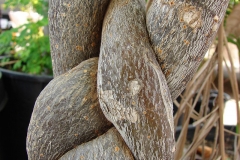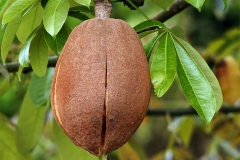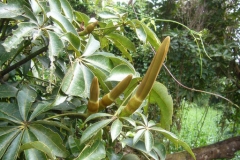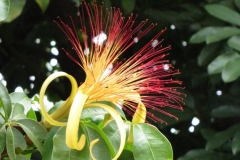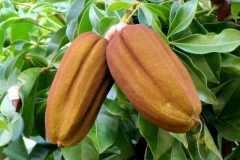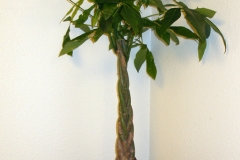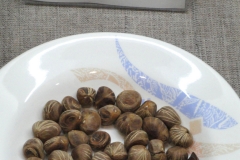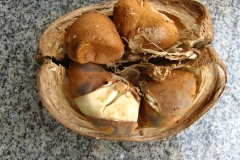Plant description
Pachira aquatic is a small to medium sized and much branched deciduous tree which reaches to the height of 17 meters having stout trunk of 90 cm diameter and buttress base. Bark is greenish when young and grey when mature. The petioles are tomentose and 11-15 cm long. Leaves are palmately compound, alternate and have 5–11 leaflets and 11–15 cm long or tomentose petioles. Leaflets are elliptic oblong or ovate-elliptical, lustrous green and about 13–28 cm long by 5–8 cm wide. Flowers are large, solitary, showy, olive green and up to 31 cm long. Fruit is ellipsoid or subglobose, pyriform dehiscent capsule upto 30 cm long by 12 cm thick, hard and olive green when immature that turns to dark brown. Fruits have five valves which is packed with numerous seeds in non-fibrous pulp. Seeds are subglobose, about 2.5 cm by 1.5–2 cm and dark brown with white spiral markings.
Flowers have large, creamy white petals which curl back to the base of the flower and leaves spectacular clusters of 7.5 to 10cm cream-white stamens.
Fruit
Fruit is five valved, woody green pod which reaches 30 cm long and 6 cm in diameter. Seeds are tightly packed and the pods burst causing the seeds to fall in the ground. Seeds are rounded and edible raw or roasted.
Traditional uses
- The skin of immature green fruit is used for treating hepatitis.
- Use the bark medicinally for treating headaches and stomach complaints.
- Tisane obtained from boiled bark is used as a tonic for blood.
- Infusion of crushed leaves is used for treating burning sensation in the skin.
- Immature fruit skin is used for treating hepatitis.
- Use the bark for treating headaches and stomach complaints.
- The decoction made from bark is used for treating high blood pressure, anemia, general debility and fatigue.
Culinary uses
- Roast the seeds or fry it in oil.
- Roasted seeds are used for preparing beverages.
- Seeds are grounded into flour and used for making breads.
- Cook young leaves and flowers and consume it as vegetable.
- Add it to salads, stir fries and consume it as snack or ground and made into hot drink.
References:
https://www.itis.gov/servlet/SingleRpt/SingleRpt?search_topic=TSN&search_value=21604#null
http://www.tropical.theferns.info/viewtropical.php?id=Pachira+aquatica
https://zoom50.wordpress.com/2010/10/06/sabamoney-tree-pachira-glabra/
https://www.specialtyproduce.com/produce/Malabar_Chestnuts_14600.php
https://gms.ctahr.hawaii.edu/gs/handler/getmedia.ashx?moid=3069&dt=3&g=12
Comments
| Malabar chestnut Quick Facts | |
|---|---|
| Name: | Malabar chestnut |
| Scientific Name: | Pachira aquatica |
| Origin | Southern parts of Mexico to Northern Peru and Northern Brazil. |
| Colors | Brown |
| Shapes | Pyriform, ellipsoid or subglobose, egg-shaped |
| Flesh colors | Olive-green |
| Name | Malabar chestnut |
|---|---|
| Scientific Name | Pachira aquatica |
| Native | Southern parts of Mexico to Northern Peru and Northern Brazil. |
| Common/English Name | American Chestnut, Guiana Chestnut, Fortune Tree, Guyana Chestnut, Money Plant, Malabar Chestnut, Money Tree, Provision Tree, Shaving Brush Tree, Saba Nut, Wild Cocoa |
| Name in Other Languages | Brazil: Cacau-selvagem, Castanha das Guianas, Carolina, Castanheiro-do-maranhão, Mamorana, Embiruçu, Paineira De Cuba, Mulungu; Chinese: Gua Li; Columbia: Zapotolongo, Zapoton; Czech: Bombakopsis vodní; Eastonian: Vesipahhiira; French: Châtaigner Sauvage, Cacaoyer-Rivière, Noisetier De La Guyane, Châtaignier De La Guyane, Pachirier Aquatique; German: Wilder Kakaobaum, Wilder Cacobaum; Guyana: Wild Cocoa; Mexico: Apompo, Zapote bobo; Portuguese: Cacau Selvagem, Astanheiro Do Maranhão, Castanheira Da água, Castanheirio Do Maranhão, Castanheiro De Guiana, Castanheiro Da Guyana, Mamorana, Monguba, Mungaba; Spanish: Apombo, Cacao Cimarron, Apompo, Cacao De Monte, Cacao De Playa, Castanho Silvestre, Castanho De Agua, Castanho, Castaño De Agua, Ceibo De Argua, Castaño De La Guayana, Ceibo De Arroya, Chila Blanca, Palo De Boya Teton, Jelinjoche, Pumpunjuche, Sapotolon, Quirillo, Sunzapote, Tsine, Zapote De Argua, Zapote Bobo, Zapotolongo, Zapoton; Venezuela: Castanho |
| Plant Growth Habit | Deciduous tree |
| Plant Size | 17 m in height |
| Bark | Smooth, brown to gray |
| Leaf | Shiny, green, palmate |
| Flower | Solitary, up to 31 cm long, showy, olive green |
| Fruit shape & size | Pyriform, ellipsoid or subglobose, egg-shaped, 20-30 cm long, diameter 10-15 cm |
| Fruit weight | 1-1.5 kg |
| Fruit color | Brown |
| Flesh color | Olive-green |
| Seed | Subglobose, 2–2.5 cm by 1.5–2 cm, dark brown |



